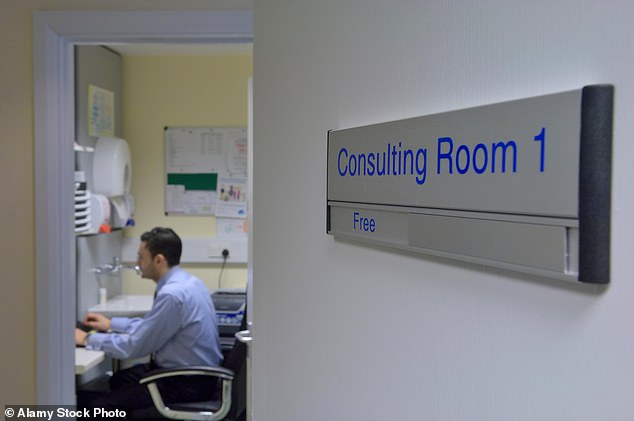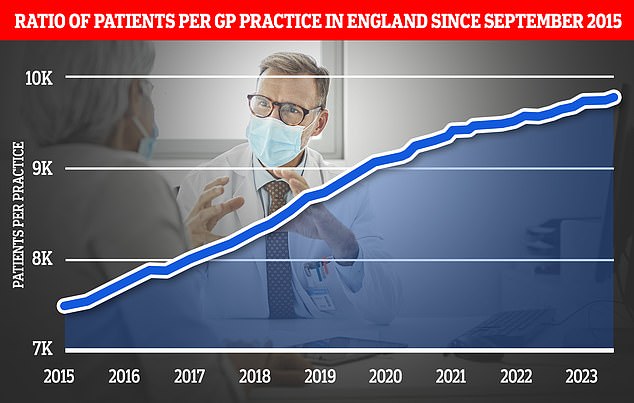Just when you thought it couldn’t get any harder to see a GP! Doctors want ‘safe limit’ of 25 appointments a day – but campaigners warn patients will flood A&E and accuse practices of ‘doing what they like’
GPs were today accused of ‘doing whatever they want’, following their calls to introduce a ‘waiting list’ for patients.
Delegates attending a conference of GP leaders at the British Medical Association (BMA) last week voted in favor of introducing a ‘safe limit’ of 25 patients per day.
GPs have reported holding up to 90 appointments a day in some areas, warning that patients rushing in in assembly line-style scenes risk missing serious illnesses.
The crisis is fueled by rising demand combined with a declining number of GPs, as many choose to retire early, work privately or even move abroad.
Adopting a safe limit would mean thousands of patients would wait longer before being seen by a GP as the daily appointment slot would be scrapped.
GP workforce data for May 2023 shows there are 27,200 fully qualified GPs in England. This is a decrease compared to the 27,627 a year earlier. The GP number peaked in March 2016 at 29,537

At the same BMA conference of Local Medical Committees (LMCs), delegates voted to ‘encourage the establishment of waiting lists for routine GP appointments’. It was argued that using such lists would ‘go some way towards’ illustrating the huge demand and hidden workloads that practices currently face. The results of the LMC meeting will form the basis for the union’s negotiating position before it enters into discussions with the Government and the NHS on the annual GP contract
At the same BMA Conference of Local Medical Committees (LMCs), delegates voted to ‘encourage the establishment of waiting lists for routine GP appointments’.
It was argued that using such lists would ‘go some way towards’ illustrating the huge demand and hidden workloads that practices currently face.
The outcomes of the LMC meeting will determine the union’s negotiating position before it enters into discussions with the government and the NHS over the annual GP contract.
But campaign groups today accused the government of ‘losing control of the situation’.
Dennis Reed of Silver Voices, which campaigns for older Britons, said if the measure were ever given the green light it would be “yet another bureaucratic barrier to access to GPs”.
He told MailOnline: ‘Our term ‘the elusive GP’ is now a reality in many parts of the country.
‘No wonder so many patients are now abandoning primary care and going straight to the local hospital.’
Experts have claimed that the difficulties in getting a GP appointment are already overwhelming emergency units battling their own crises.
Mr Reed added: ‘The Government has lost control of the situation and GP practices are doing what they want.’
The BMA already recommends that GPs should make no more than 25 appointments per day to ensure safe care.
But the conference ruled that it should become a ‘red line’ in the coming contract negotiations.
It also demanded that NHS England ‘make appropriate provision for all practices across England to divert urgent workloads when their daily safe working limits have been reached’.
The latest NHS data shows there were 31.1 million GP appointments in September, with figures rising to the fourth highest ever.
Less than half were on the same day (40 percent) and a third (34.5 percent) had to wait longer than a week.
The latest data for England shows that 71 percent of GP consultations take place face-to-face, while 24 percent take place by telephone.
Dr. David Wrigley, vice-chair of the BMA’s UK GP committee, told MailOnline: ‘The BMA supports policies that aim to ensure a safe level of patient contacts per day for GPs.
‘This is reflected in our safer working policy and guidelines, which recommend no more than 25 patient contacts per day.
‘Practices can, as has always been the case, refer patients to other services.
‘Safer working will form a key part of negotiations with NHS England on the contract for 2024/25 and beyond.’

The BMA already recommends that GPs should make no more than 25 appointments per day to ensure safe care. But the conference ruled that it should become a ‘red line’ in the coming contract negotiations. Chart shows the ratio of GP patients to practices since 2015, with an average of 9,755 patients per surgery in May 2023
He added: ‘As long as GPs do not feel safe in their daily clinical work, it will be impossible for general practices to maintain their workforce.
‘Only if waiting lists and workload issues are properly addressed can we deliver the highest quality of care and ensure better outcomes for patients.’
Professor Kamila Hawthorne, President of the Royal College of GPs, said: ‘No two GP practice appointments are the same and patient contact numbers will vary depending on which clinical healthcare staff member sees the patient, the practice and the patient’s circumstances, and the clinical judgement. .
‘Practices will deal with this as best they can, based on their knowledge of their local patient population.
‘However, there comes a point where demand exceeds capacity and GPs can no longer guarantee safe care to their patients. That is why we urgently need to find a range of solutions for this.’
In the wake of the pandemic, patient satisfaction among GPs has fallen to its lowest level ever.
Patients have consistently expressed frustration with access, especially regarding in-person face-to-face appointments.
GPs say they are overwhelmed by the pressure of a rising and aging population, a lack of government funding and a shortage of doctors.
Ministers have also quietly abandoned a promise to hire a further 6,000 GPs, which was a key part of Boris Johnson’s election-winning manifesto. Since 2019, only 2,000 general practitioners have been added.
The workforce crisis is exacerbated by the fact that many current GPs are retiring at 50, moving abroad or working in the private sector due to rising demand, NHS paperwork and aggressive media reporting.
GP practices have also experienced increasing intimidation, assault and verbal abuse against staff in recent months.
It comes after a major study today warned that online and telephone GP appointments can miss serious illnesses and put patients at risk of fatal mistakes.
Older people and others with urgent conditions face misdiagnosis and potentially fatal delays in care that would be less likely if seen face-to-face, the analysis suggested.
